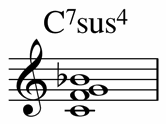The sus4 chord can be found in most genres of music; blues, jazz, rock, classical, folk, hip hop, etc.
In a normal C7 chord, the 4 notes are C (the root), E (the major 3rd), G (the 5th), Bb (the b7).
In a C7 sus4 chord the notes are C (the root), F (the 4th), G (the fifth) and Bb (the b7).
“Sus” is shorthand for “suspended” as the 4th degree is suspended above the 3rd; wanting to resolve down to the 3rd.
In the most common sus4 voicing the 3rd is replaced by the 4th, however, it is common practice to include both the 4th and natural 3rd in the voicing as well (i.e. C, F, G, Bb, E). The most commonly used chord-scale for a sus4 chord is the mixolydian scale which also contains both the natural 3rd and the natural 4th (C mixolydian: C, D, E, F, G, A, Bb, C). This chord is often considered to be the dominant 7th chord with the least amount of tension.
The melody below will help you hear the sound of the Sus chord by focusing on just the 4 primary notes of the sound (1,4,5,b7). Remember that the melody below is just one way to work with the 4 notes and its purpose is to help you learn to hear the sound and to understand the chord in all 12 keys. Try to expand from the melody by varying the rhythm and order of notes. Make sure you can play the sound in every key to help facilitate the connection between your ear and your instrument. Ideally, if you can hear it and sing it in one key, you should be able to play it in all 12 keys.
For most practical purposes this chord can be treated as a regular dominant 7 in terms of how it functions harmonically. Once you’re comfortable with the primary 4 notes of the sus4 7th chord try improvising using all 7 notes from the mixolydian scale while still hearing and emphasizing the sus4 sound.
~Enjoy!
.
Here’s an mp3 of the melody:
.
.

